- Benefits of Growing Tomatoes in Bags
- Choosing the Right Bags for Tomato Cultivation
- Selecting the Best Tomato Varieties for Bag Cultivation
- 1. Cherry Tomatoes
- 2. Determinate Tomatoes
- 3. Heirloom Tomatoes
- Preparing the Bags for Tomato Planting
- 1. Choosing the Right Bags
- 2. Creating Drainage Holes
- 3. Filling the Bags
- 4. Adding Fertilizer
- 5. Watering the Soil
- 6. Placing the Bags
- Planting Tomatoes in Bags: Step-by-Step Guide
- What You’ll Need
- Step 1: Choose the Right Bags
- Step 2: Prepare the Bags
- Step 3: Plant the Tomato Seedlings
- Step 4: Water the Plants
- Step 5: Provide Support
- Step 6: Regular Maintenance
- Step 7: Harvesting
- Caring for Tomato Plants in Bags: Watering, Fertilizing, and Pruning
- Watering
- Fertilizing
- Pruning
- Troubleshooting Common Issues in Bag Cultivation
- Poor Drainage
- Limited Nutrients
- Pest Infestations
- Disease Outbreaks
- Temperature Extremes
- Inconsistent Watering
- Improper Pruning
- Harvesting and Storing Tomatoes Grown in Bags
- Harvesting Tips:
- Storing Tips:
- “Question-Answer”
- What are the advantages of growing tomatoes in bags?
- What kind of bags are suitable for growing tomatoes?
- What type of soil should be used for growing tomatoes in bags?
- Can any tomato variety be grown in bags?
- How often should tomatoes in bags be watered?
- Do tomatoes grown in bags require additional support?
- “Video” Three Easy Methods to Trellis and Support Tomatoes (Grow Bags Too!)
When it comes to growing tomatoes, traditional methods often involve planting them in the ground. However, there is a modern and efficient method that is gaining popularity among gardeners – growing tomatoes in bags. This innovative technique offers a range of advantages over traditional methods and allows even those with limited space to enjoy fresh and delicious tomatoes.
One of the key advantages of growing tomatoes in bags is the flexibility it offers. Unlike planting in the ground, bags can be moved around and placed in any location that receives adequate sunlight. This means that even if you don’t have a large backyard or a dedicated gardening area, you can still successfully grow tomatoes by using bags. Whether you have a balcony, a patio, or a small plot of land, this method can be adapted to suit your space.
Another advantage of growing tomatoes in bags is the control it gives you over the growing conditions. With bags, you can easily regulate the soil quality and water drainage, ensuring optimal conditions for tomato growth. Additionally, the use of bags minimizes the risk of soil-borne diseases and pests, as the bags provide a barrier between the plants and the potentially harmful elements in the ground. This makes it easier to maintain a healthy and thriving tomato crop.
In conclusion, growing tomatoes in bags is a modern and efficient method that offers numerous advantages over traditional planting methods. With the flexibility to adapt to any space and the ability to control growing conditions, this method allows even those with limited gardening experience to successfully grow delicious tomatoes. Whether you have a small urban garden or a balcony, consider trying this innovative technique for a bountiful tomato harvest.
Benefits of Growing Tomatoes in Bags
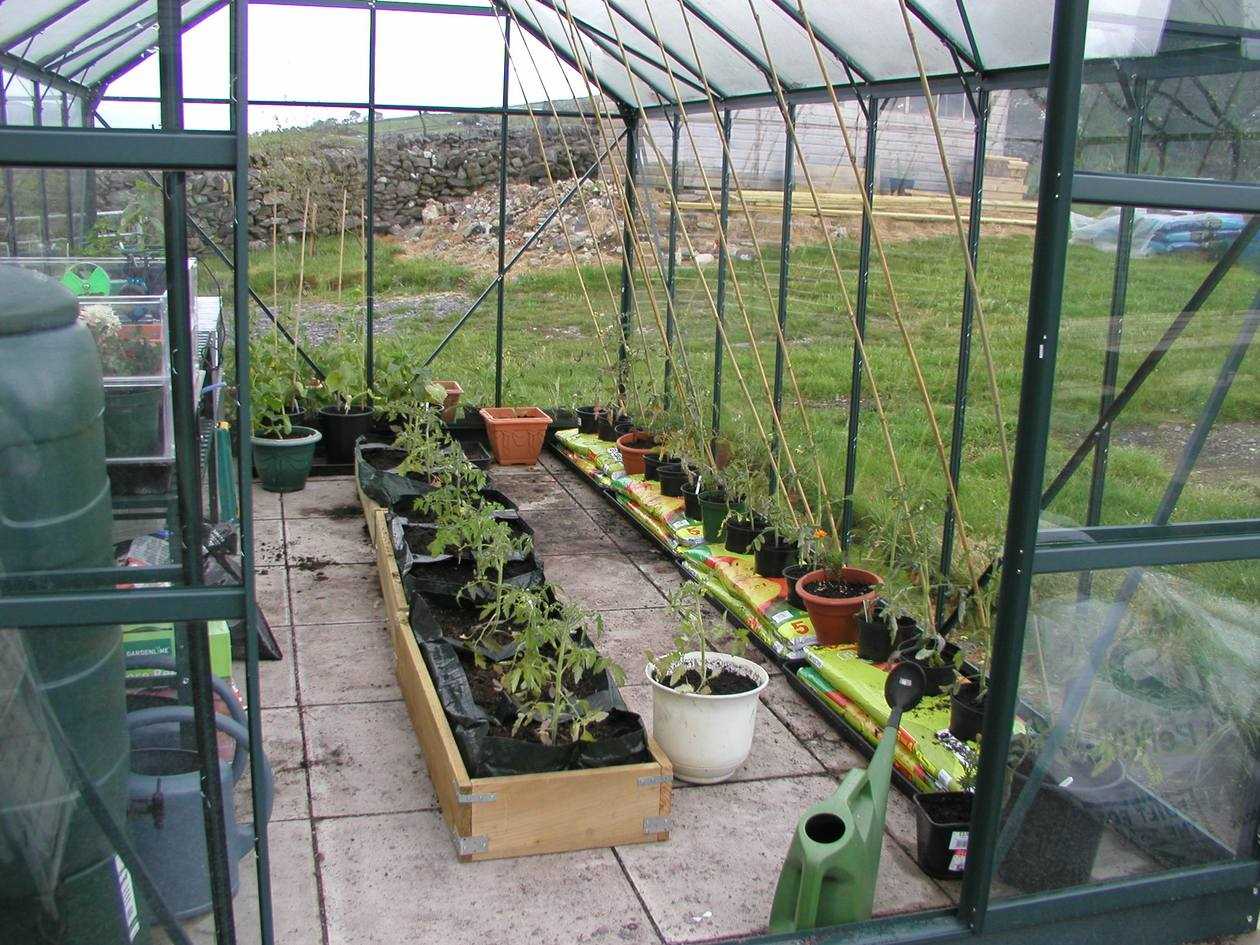
There are several benefits to growing tomatoes in bags compared to traditional methods:
- Space-saving: Growing tomatoes in bags allows you to utilize small spaces more effectively, making it ideal for urban gardening or those with limited garden space.
- Portability: Tomato bags can be easily moved around, allowing you to follow the sun or protect plants from extreme weather conditions.
- Weed control: When tomatoes are planted in bags, it helps reduce the growth of weeds, making it easier to maintain and care for your plants.
- Disease prevention: Bag cultivation helps reduce the risk of soil-borne diseases that can affect tomatoes. Since the bags use fresh potting soil, the chance of contamination is minimized.
- Improved drainage: Bags are designed with proper drainage, preventing the soil from becoming waterlogged and reducing the risk of root rot.
- More control over soil quality: By using bags, you have full control over the type and quality of soil you use, allowing you to optimize growing conditions for your tomatoes.
- Efficiency: Bag cultivation eliminates the need for excessive watering. The bags retain moisture, reducing water evaporation, and ensuring the plants have access to a consistent water supply.
- Improved air circulation: Growing tomatoes in bags provides better air circulation around the plants, reducing the likelihood of fungal infections and promoting healthier growth.
- Ease of harvesting: Bags make it easy to pick ripe tomatoes without having to bend down or negotiate plants in the ground, making the process more efficient and comfortable.
- Less risk of pests: Bag cultivation can help reduce the risk of pests since the plants are elevated and isolated from pest-infested soil.
Choosing the Right Bags for Tomato Cultivation
When it comes to growing tomatoes in bags, choosing the right type of bags is essential for the success of your cultivation. Here are some factors to consider when selecting bags for tomato cultivation:
- Materials: The material of the bags plays a crucial role in the overall growth and health of the tomato plants. It is recommended to use bags made of breathable and durable materials such as fabric or geotextile. These materials allow proper air circulation and drainage, preventing waterlogging and root rot.
- Size: The size of the bags should be chosen based on the space available for cultivation and the type of tomato plants you are growing. Smaller bags are suitable for compact varieties, while larger bags are needed for indeterminate varieties that require more space for root development.
- Handles: Bags with handles make it easier to move and position them as needed. This is especially useful when you need to move the bags to take advantage of sunlight or protect the plants from extreme weather conditions.
- UV resistance: Since the bags will be exposed to sunlight, it is important to choose bags that are UV resistant. UV resistant bags are able to withstand prolonged sun exposure without deteriorating, ensuring their longevity.
- Reusable: Opting for reusable bags is a more sustainable choice. Look for bags that are easy to clean and can be used for multiple growing seasons.
By considering these factors, you can select the right bags for tomato cultivation that will provide optimal conditions for the growth and development of your tomato plants.
Selecting the Best Tomato Varieties for Bag Cultivation
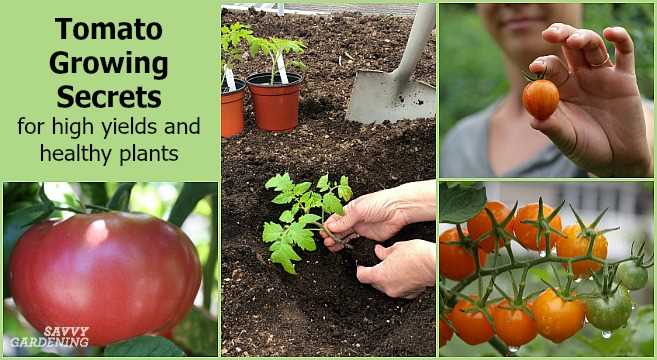
Growing tomatoes in bags provides the opportunity to cultivate a wide variety of tomato plants in a compact and efficient manner. When selecting the best tomato varieties for bag cultivation, it is important to consider several factors such as the plant’s growth habit, fruit size, disease resistance, and overall flavor. Here are some popular tomato varieties that are well-suited for bag cultivation:
1. Cherry Tomatoes
- Sweet 100: This indeterminate cherry tomato variety produces an abundant crop of small, sweet fruits. It is known for its disease resistance and is a popular choice for bag cultivation.
- Red Cherry: Another indeterminate variety, Red Cherry tomatoes are a classic choice for bag cultivation. They have a rich, sweet flavor and are great for snacking, salads, or garnishing dishes.
- Yellow Pear: These small, yellow pear-shaped tomatoes are a delightful addition to any tomato collection. They have a sweet, tangy flavor and are perfect for adding color and variety to salads.
2. Determinate Tomatoes
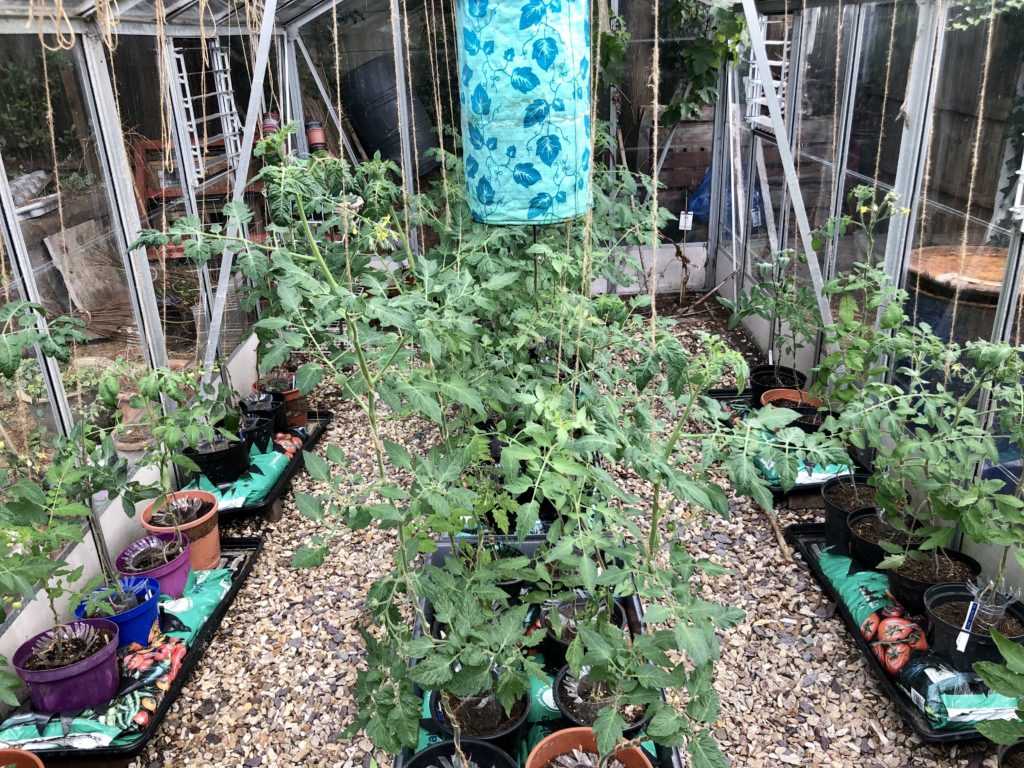
- Roma: Roma tomatoes are a popular choice for bag cultivation due to their compact growth habit. They produce an abundance of meaty, flavorful fruits that are perfect for making sauces and salsas.
- Celebrity: This determinate variety is known for its disease resistance and ability to thrive in various growing conditions. It produces large, flavorful fruits that are excellent for slicing and using in sandwiches.
3. Heirloom Tomatoes
- Brandywine: Brandywine tomatoes are a favorite among tomato enthusiasts for their exceptional flavor. They have large, pink fruits with a rich, sweet taste and are ideal for bag cultivation due to their indeterminate growth habit.
- Cherokee Purple: Another popular heirloom variety, Cherokee Purple tomatoes have a unique, dark purple color and a rich, smoky flavor. They are a great choice for bag cultivation as they have good disease resistance and produce well in containers.
When selecting tomato varieties for bag cultivation, it is also important to consider your climate and growing conditions. Some varieties may perform better in certain climates or require specific care. Additionally, it can be fun to experiment with different varieties to discover new flavors and colors.
In conclusion, choosing the best tomato varieties for bag cultivation involves considering factors such as growth habit, fruit size, disease resistance, and flavor. The cherry, determinate, and heirloom varieties mentioned above are all excellent choices for bag cultivation, but there are many other options available. Happy tomato growing!
Preparing the Bags for Tomato Planting
Before planting your tomato seeds or seedlings in bags, it is important to properly prepare the bags to create an optimal environment for growth. Following these steps will help ensure the success of your tomato plants:
1. Choosing the Right Bags
Select high-quality bags that are made of durable material and have good drainage capabilities. Avoid using bags that are too small, as they may restrict root growth.
2. Creating Drainage Holes
Using a sharp knife or scissors, create several drainage holes at the bottom of each bag. This will prevent water from pooling and causing root rot.
3. Filling the Bags
Fill each bag with a well-draining soil mixture. You can create your own mixture by combining equal parts of garden soil, compost, and perlite or vermiculite. Alternatively, you can purchase a pre-made potting mix from a garden center.
4. Adding Fertilizer
Mix in a slow-release fertilizer or organic compost into the soil mixture before filling the bags. This will provide the necessary nutrients for the tomato plants to thrive.
5. Watering the Soil
Before planting the tomato seeds or seedlings, thoroughly moisten the soil in the bags. This will help settle the soil and create a favorable environment for root development.
6. Placing the Bags
Choose a sunny location with at least 6-8 hours of direct sunlight per day. Place the prepared bags in this area, ensuring they are stable and won’t tip over.
By following these steps and properly preparing the bags, you can create an ideal environment for your tomato plants to grow and thrive. This method of growing tomatoes in bags provides multiple advantages, such as better control of soil conditions, improved root development, and easy mobility.
Planting Tomatoes in Bags: Step-by-Step Guide
What You’ll Need
- Plastic bags or grow bags with drainage holes
- Tomato seedlings
- Potting soil
- Fertilizer
- Watering can or hose
- Gardening tools (such as a trowel)
Step 1: Choose the Right Bags
Start by selecting the suitable plastic bags or grow bags for planting tomatoes. Ensure that the bags have proper drainage holes to prevent waterlogging.
Step 2: Prepare the Bags
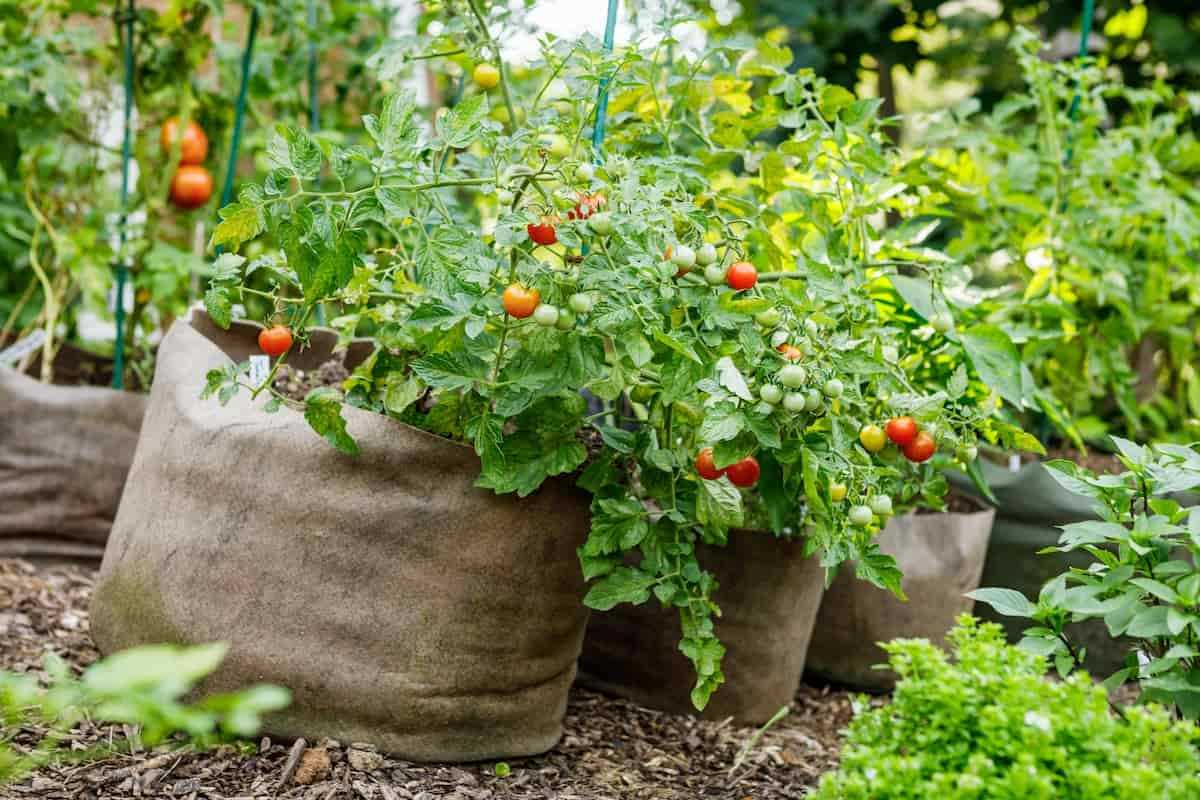
- Fill each bag with high-quality potting soil up to around 2/3 of its capacity.
- Add a layer of slow-release fertilizer to provide essential nutrients to the plants.
- Thoroughly mix the fertilizer into the soil to distribute it evenly.
Step 3: Plant the Tomato Seedlings
- Make a small hole in the center of the bag that is deep enough to accommodate the roots of the tomato seedling.
- Carefully remove the tomato seedling from its container, keeping the roots intact.
- Place the tomato seedling into the hole and gently backfill the soil around the roots, ensuring that it is snugly held in place.
Step 4: Water the Plants
After planting the tomato seedlings, water them thoroughly to help settle the soil and provide moisture to the plants. Avoid overwatering as it can lead to root rot.
Step 5: Provide Support
If you are growing indeterminate tomato varieties that require support, insert stakes or cages into the bags to provide stability and prevent the plants from falling over.
Step 6: Regular Maintenance
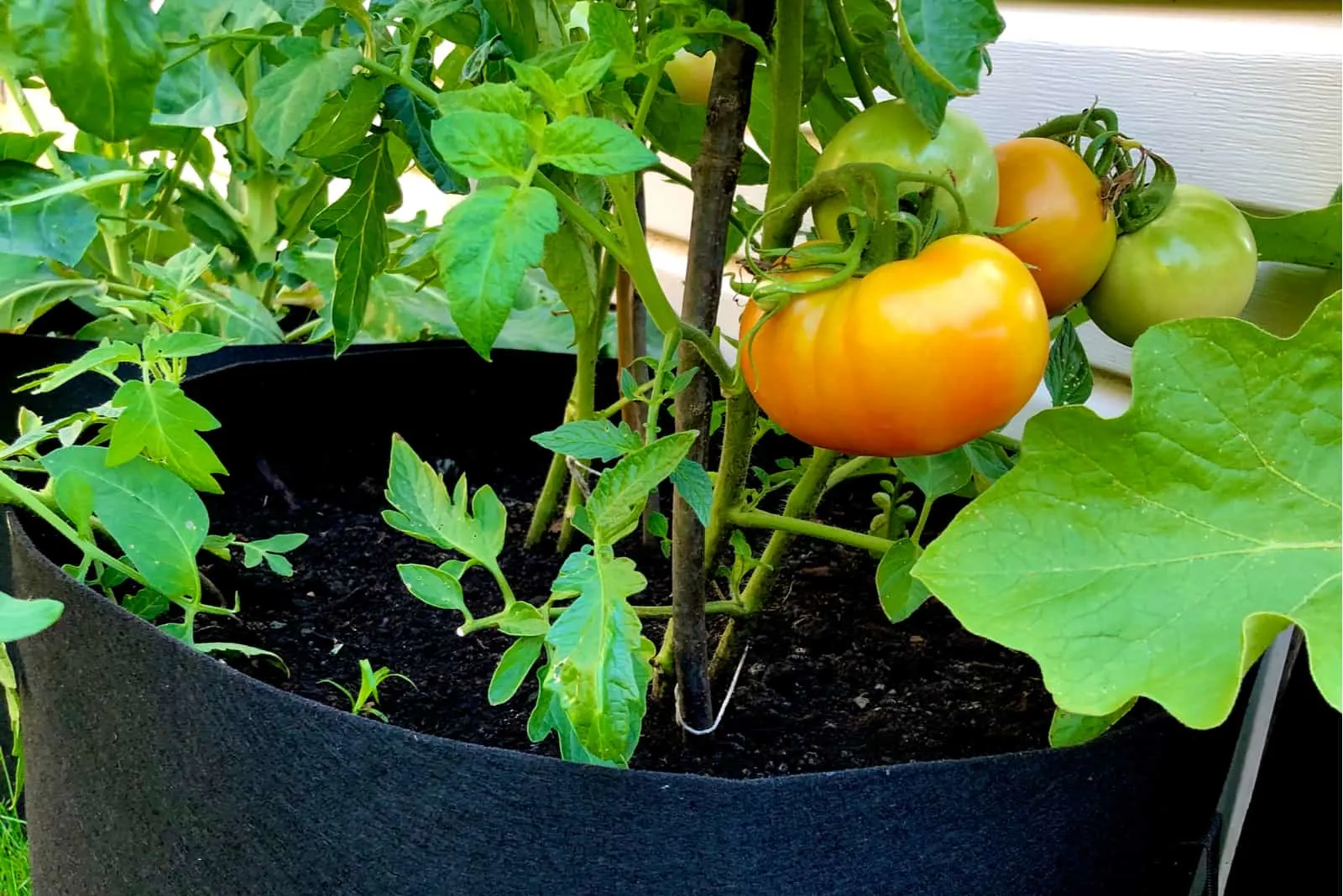
- Monitor the moisture level of the soil and water the plants as needed to keep the soil evenly moist.
- Apply fertilizer according to the recommended dosage and schedule to promote healthy growth and fruit development.
- Remove any weeds or unwanted plants that may compete for nutrients and space.
- Prune the tomato plants by removing the suckers to maintain a single, strong stem.
Step 7: Harvesting
Once the tomato plants start producing ripe fruits, regularly check and harvest them when they are firm and fully colored. Enjoy the fresh and delicious homegrown tomatoes!
Caring for Tomato Plants in Bags: Watering, Fertilizing, and Pruning
Once you have successfully planted your tomato plants in bags, it is important to provide proper care to ensure their healthy growth and bountiful harvest. Caring for tomato plants in bags involves three key aspects: watering, fertilizing, and pruning. Let’s explore each of these in detail:
Watering
Tomato plants require regular and consistent watering to thrive. The bags should be watered deeply and evenly, ensuring that the soil is moist but not waterlogged. Monitor the moisture level in the bags and adjust the watering frequency accordingly, taking into account factors such as temperature, humidity, and the size of the plants. Avoid overwatering, as it can lead to root rot and other diseases.
One effective watering method is to use drip irrigation or a soaker hose. This allows water to be delivered directly to the plant’s root zone, minimizing water wastage and reducing the risk of water-related diseases. Mulching the soil surface with organic matter can also help retain moisture and regulate soil temperature.
Fertilizing
Tomato plants are heavy feeders, and they require a steady supply of nutrients for optimal growth and fruit production. Fertilizing your tomato plants in bags is essential to provide them with the necessary nutrients. Use a balanced fertilizer or one specifically formulated for tomatoes, following the manufacturer’s instructions for application rates.
Apply the fertilizer evenly around the base of the plants and gently work it into the soil. To prevent fertilizer burn, avoid direct contact of the fertilizer with the plant’s stem or foliage. It is also beneficial to supplement the soil with organic matter, such as compost or well-rotted manure, to improve soil fertility and enhance nutrient availability.
Pruning
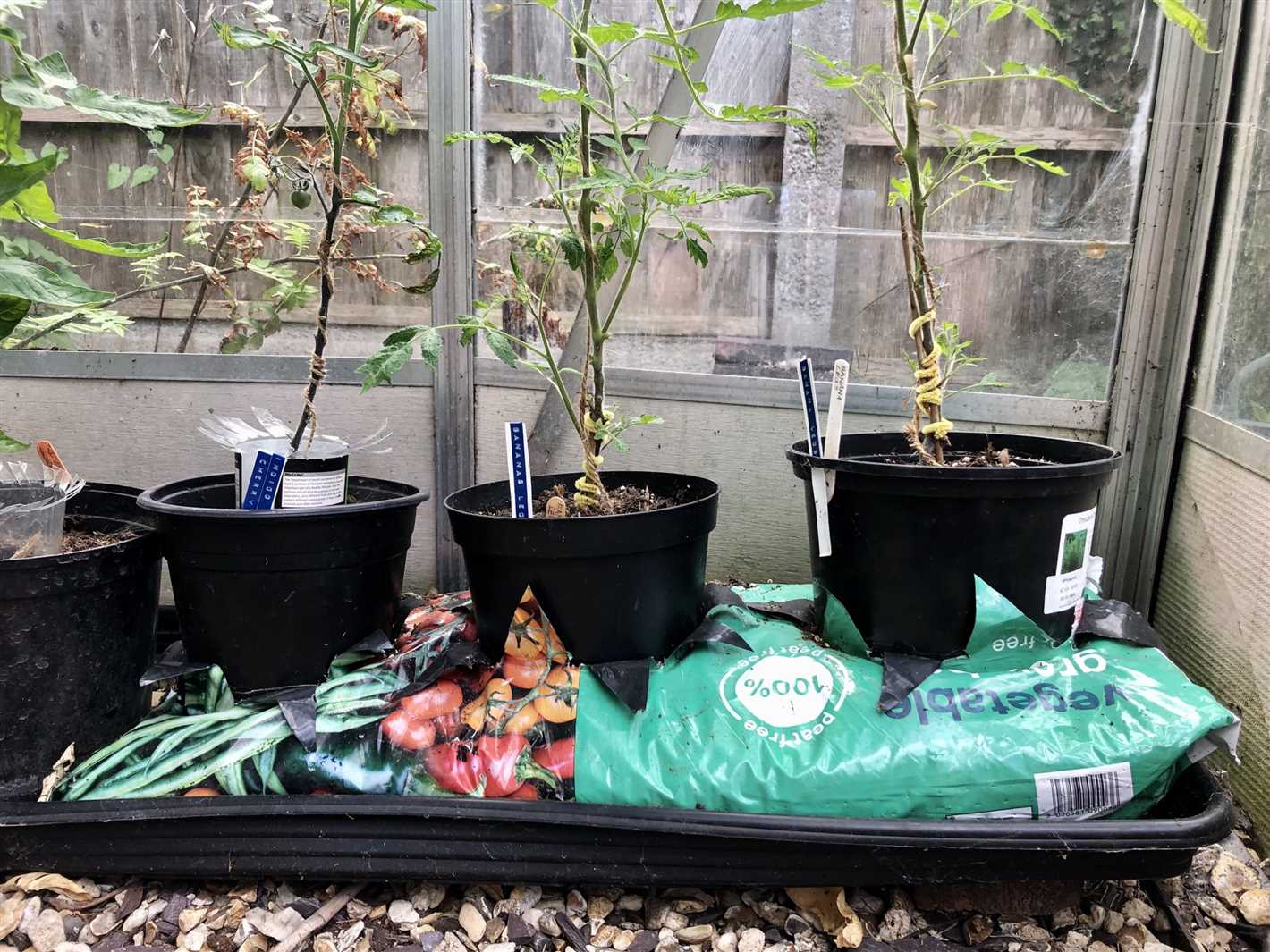
Pruning tomato plants helps improve air circulation, reduce disease incidence, and promote better fruit development. Regular pruning is especially important for indeterminate tomato varieties, which continue to grow and produce throughout the season.
Remove any suckers that develop in the leaf axils, as they divert energy from the main stem. Use clean and sharp pruners to make smooth cuts, minimizing the risk of disease transmission. Additionally, remove any yellowing or diseased leaves promptly to prevent the spread of infection.
Consider using stakes, trellises, or cages to support the tomato plants and keep them upright. This not only helps prevent breakage but also facilitates better air circulation and sun exposure, leading to healthier plants and higher yields.
In conclusion, caring for tomato plants in bags involves proper watering, timely fertilization, and regular pruning. Providing these essential care practices will help ensure strong and productive tomato plants that reward you with a bountiful harvest.
Troubleshooting Common Issues in Bag Cultivation
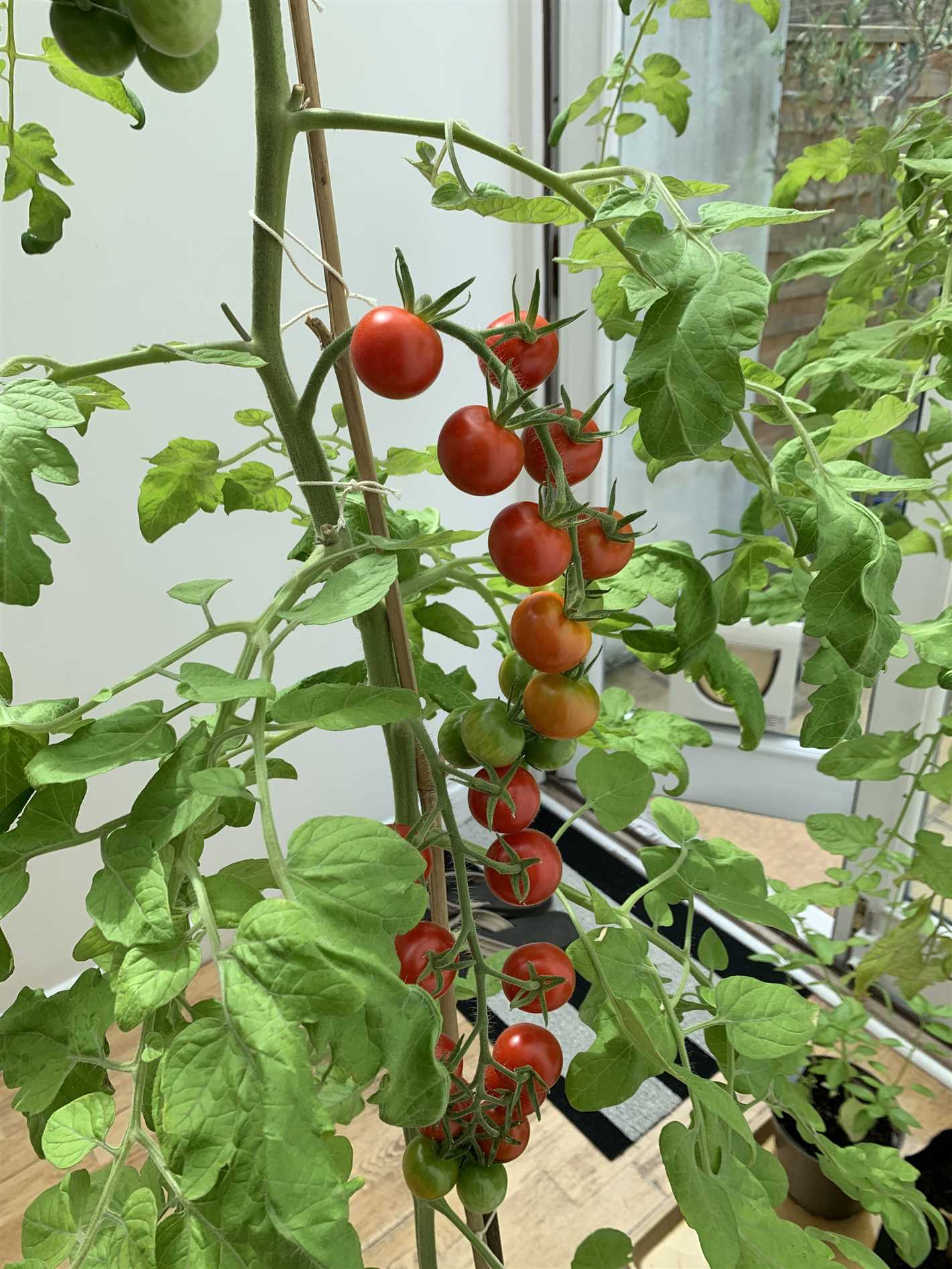
Growing tomatoes in bags can be a highly efficient method, but like any form of cultivation, it can come with its own set of challenges. Here are some common issues you may encounter and their solutions:
Poor Drainage
If you find that your plants are constantly sitting in water and the bags are not draining properly, it can lead to root rot and other issues. To improve drainage, make sure the bottom of the bag has sufficient holes for water to flow out. You can also add a layer of gravel or pebbles at the bottom of the bag to aid in drainage.
Limited Nutrients
Bags may have less capacity for holding nutrients compared to traditional soil beds. It’s important to regularly fertilize your plants to ensure they are receiving the necessary nutrients. Consider using slow-release fertilizers or organic fertilizers to provide a steady supply of nutrients over time.
Pest Infestations
Pests such as aphids, whiteflies, and spider mites can cause damage to your tomato plants. To prevent infestations, regularly inspect your plants for signs of pests and take action promptly if any are detected. You can use organic insecticides, such as neem oil, or introduce natural predators like ladybugs to control the pest population.
Disease Outbreaks
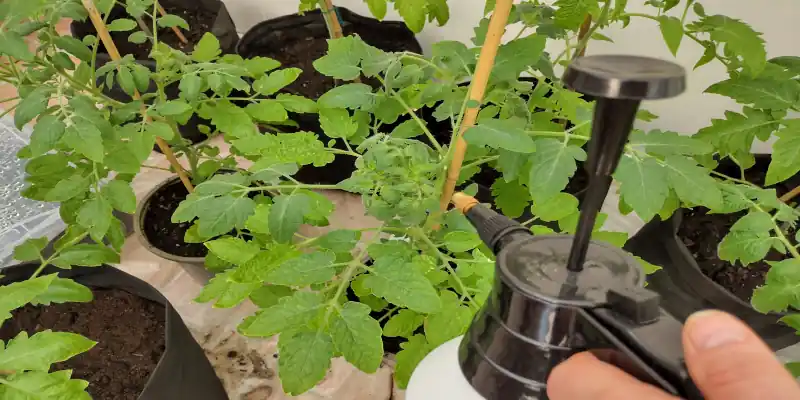
Tomatoes are prone to various diseases like blight, fungal infections, and bacterial wilt. To prevent disease outbreaks, practice good hygiene by removing any infected plants or leaves immediately. Avoid overhead watering as it can promote disease spread. Use disease-resistant varieties when possible and rotate your crops to minimize disease pressure.
Temperature Extremes
Extreme temperatures can affect tomato growth and yield. High temperatures can cause fruit drop and poor pollination, while low temperatures can stunt growth and lead to cold damage. Provide shade during hot periods and use mulch to keep the soil temperature more stable. Consider using season-extending methods like row covers or greenhouses in regions with cold climates.
Inconsistent Watering
Tomato plants need consistent moisture to thrive. Inconsistent watering can cause fruit cracking and blossom end rot. Water your plants deeply and evenly, and avoid letting the soil dry out completely or become waterlogged. Consider using drip irrigation systems or self-watering bags to maintain a consistent level of moisture.
Improper Pruning
Pruning is essential for managing the growth and productivity of tomato plants. Improper pruning can lead to overcrowding, poor air circulation, and reduced fruit production. Learn the proper techniques for pruning tomatoes, including removing suckers and unnecessary foliage, to maximize plant health and yield.
By being aware of these common issues and taking proactive measures to address them, you can ensure a successful bag cultivation of tomatoes and enjoy a bountiful harvest. Happy growing!
Harvesting and Storing Tomatoes Grown in Bags
Harvesting tomatoes grown in bags is a straightforward process that can be done by following a few simple steps. Once the tomatoes are ripe and ready for picking, you can start enjoying the delicious taste of your homegrown produce.
Harvesting Tips:
- Check the color: Ripe tomatoes will have a vibrant red, yellow, or orange color, depending on the variety.
- Feel the texture: Gently squeeze the tomato to check for firmness. Ripe tomatoes should be slightly soft but not mushy.
- Observe the stem: Look for a dry and brittle stem. If the stem is green and attached firmly to the fruit, the tomato may not be fully ripe.
- Use pruning shears or scissors: To harvest the tomatoes, use clean pruning shears or scissors to cut the fruit from the vine. This helps prevent damage to the plant.
Storing Tips:
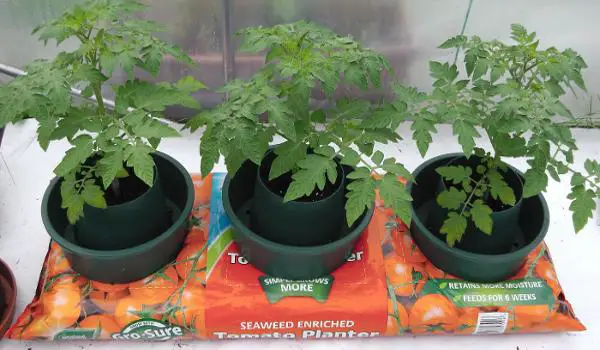
Proper storage is essential to ensure the longevity and flavor of your freshly harvested tomatoes. Here are some tips for storing tomatoes grown in bags:
- Avoid direct sunlight: Tomatoes should be stored in a cool and dark place, away from direct sunlight. Sunlight can cause the tomatoes to ripen too quickly and spoil.
- Separate ripe and unripe tomatoes: If you have a mix of ripe and unripe tomatoes, it’s best to store them separately. Ripe tomatoes can release ethylene gas, which can accelerate the ripening process of unripe ones.
- Store at room temperature: Ripe tomatoes can be stored at room temperature for a few days to maintain their flavor and texture. However, make sure to check them regularly and use them before they overripen.
- Refrigerate only if necessary: If you have an excess of ripe tomatoes or want to extend their shelf life, you can store them in the refrigerator. However, keep in mind that refrigeration can affect the texture and taste of tomatoes, so it’s best to consume them within a few days.
By following these harvesting and storing tips, you can enjoy the fruits of your labor and savor the taste of freshly picked tomatoes grown in bags for an extended period.
“Question-Answer”
What are the advantages of growing tomatoes in bags?
Growing tomatoes in bags has several advantages. Firstly, it allows for better control over soil conditions, which ensures optimal growth and productivity. Secondly, bag cultivation can save space and is particularly useful for urban gardeners with limited space. Additionally, bags are portable and can be moved easily to take advantage of sunlight and better growing conditions. Lastly, growing tomatoes in bags reduces the risk of soil-borne diseases and pests, as the bags provide a protective barrier.
What kind of bags are suitable for growing tomatoes?
For growing tomatoes in bags, it is best to use grow bags made of sturdy, breathable fabric. These bags allow for proper drainage and aeration of the roots, promoting healthy growth. Plastic bags should be avoided as they can retain too much moisture and cause root rot. Additionally, fabric bags can be easily folded and stored when not in use, making them convenient for gardeners with limited space.
What type of soil should be used for growing tomatoes in bags?
The ideal soil mix for growing tomatoes in bags is a combination of potting soil, compost, and perlite or vermiculite for drainage. This mix provides the necessary nutrients, water retention, and aeration for healthy tomato growth. It is important to avoid using garden soil, as it may contain pests, diseases, or weed seeds that can harm the tomato plants. It is also recommended to add organic fertilizer or slow-release fertilizer to ensure continuous nutrient supply.
Can any tomato variety be grown in bags?
Most tomato varieties can be grown in bags, as long as they are suitable for container gardening. Compact or determinate varieties are generally preferred for bag cultivation, as they require less space and support. Some popular tomato varieties for growing in bags include ‘Celebrity’, ‘Patio’, ‘Roma’, and ‘Sweet 100’. It is important to choose disease-resistant varieties to minimize the risk of plant damage.
How often should tomatoes in bags be watered?
The frequency of watering tomatoes in bags depends on various factors such as weather conditions, bag size, and plant size. In general, it is important to keep the soil consistently moist but not waterlogged. It is recommended to water the plants deeply when the top inch of soil feels dry. The bags should have drainage holes to prevent water from pooling at the bottom. Regular monitoring of the soil moisture and adjusting the watering schedule accordingly is key to maintaining healthy tomato plants.
Do tomatoes grown in bags require additional support?
Tomatoes grown in bags may require additional support, especially if they are indeterminate or vining varieties that grow tall. Providing support helps to prevent the plants from toppling over and makes it easier to manage their growth. This can be done by using stakes, trellises, or tomato cages. It is important to install the support structures at the time of planting or soon after to avoid damaging the roots later on. Additionally, regular pruning and removing suckers can help in controlling the size and shape of the tomato plants.







